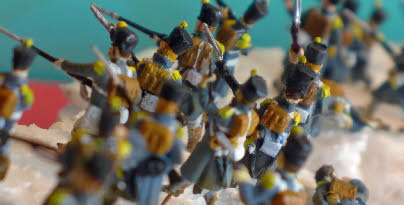
Borodino to Waterloo: Rayevsky’s Redoubt, the wounding of the Prince of Orange & d’Erlon’s attack
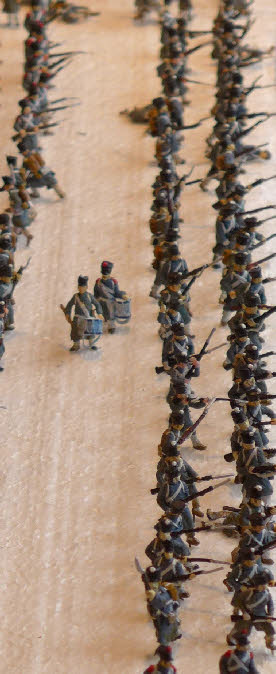
1815 Waterloo - The counter-attack on d’Erlon by Netherlands infantry and the Inniskilling dragoons
The Concept
The Concept
Quiot’s Division moved up and after a fire fight with Bijland’s brigade the latter withdrew behind the Chemin d'Ohain road. Quiot’s lead brigade, the Bourgeois brigade was comprised of 2 regiments, the 105th& 28th. What was happening to the second brigade is disputed. Although it set off behind Bourgeois, it appears that this second brigade (54th & 55th) moved up to the right of the first. But were they in parallel when fighting the Allied infantry or in echelon behind (as happened with the Division to the French right)? Accounts from the Inniskillings suggest the latter, ie some of them charged some distance to make contact with the enemy. I have chosen this answer, thus splitting my British cavalry into two: one part hitting the 105th, the other charging downhill.
The lead battalion of the 105th Line had pushed through the hedgerow lining the road and found itself opposed by the regrouped Belgian/Dutch troops (the 27th Jaegers were originally part reserve position behind the guns and so held that position which now became the first line) and British infantry. Part of Bourgeois’ brigade was thus on the northern side of the road, some on the road with the remaining troops still of the upward slope. All this contributed to the disorganisation of the French, who had lost considerable soldier numbers to artillery, skirmishing and line fire-fight. Thus whilst the two battalions should have been 6 rows deep would have been somewhat less than that number.
The lead battalion of the 105th Line had pushed through the hedgerow lining the road and found itself opposed by the regrouped Belgian/Dutch troops (the 27th Jaegers were originally part reserve position behind the guns and so held that position which now became the first line) and British infantry. Part of Bourgeois’ brigade was thus on the northern side of the road, some on the road with the remaining troops still of the upward slope. All this contributed to the disorganisation of the French, who had lost considerable soldier numbers to artillery, skirmishing and line fire-fight. Thus whilst the two battalions should have been 6 rows deep would have been somewhat less than that number.
The centrepiece of the diorama will be the 105th Some of the 28th will also be featured but the extent will depend largely how much time I have.
Each battalion would have been a maximum of 550 all ranks on the morning (having not been engaged in action beforehand). It had two battalions so my representation of 265 figures thus something like 1:4 ratio. I cannot waver from showing a three line ranking per battalion so I have to compromise with the line length which is thus about quarter the length is should be. I did consider just representing the right hand quarter of the regiment, but felt a better ‘feel’ of a column in attack mode would ensue by showing all six companies of each battalion.
Each battalion would have been a maximum of 550 all ranks on the morning (having not been engaged in action beforehand). It had two battalions so my representation of 265 figures thus something like 1:4 ratio. I cannot waver from showing a three line ranking per battalion so I have to compromise with the line length which is thus about quarter the length is should be. I did consider just representing the right hand quarter of the regiment, but felt a better ‘feel’ of a column in attack mode would ensue by showing all six companies of each battalion.
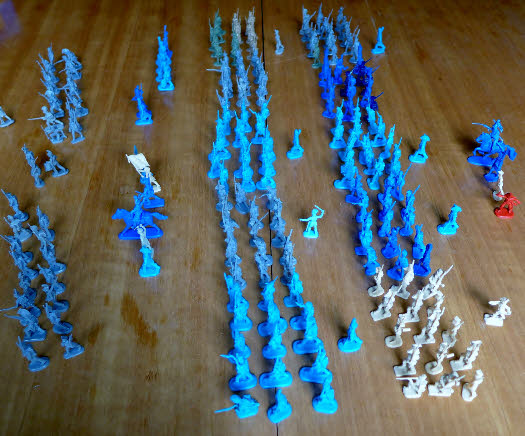
Picture 1: the regiment at the start of the battle. Each battalion has 6 companies, one of which is the light company thrown forward in skirmishing role. Whilst the French artillery bombarded the Allied lines, and whilst waiting to start their assault, the regiment would itself have been under fire from the Allied Artillery. I have allowed 4 (17) soldier casualties for this period.
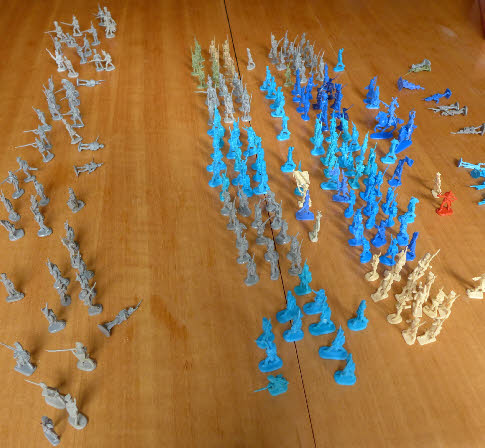
Picture 2: the assault up to the road. Volitgeurs from other French regiments join to form a substantial French skirmish screen to push back the Allied equivalent. 105th casualties from Allied artillery and skirmish screen: (plus Volitgeurs from the other regiments shown in the distance)
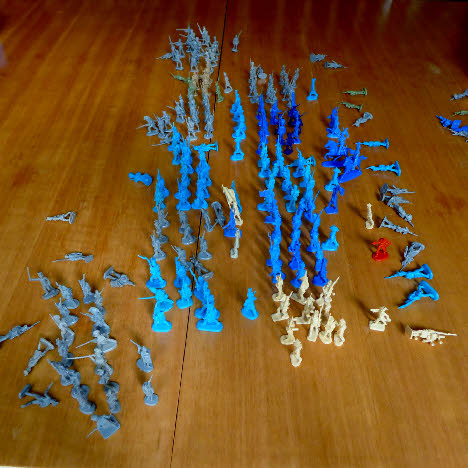
Picture 3: the 105th’s Volitgeurs have moved to the regiment’s left flank whilst those from other French regiments have moved to the right. The firefight with the Netherlands/British troops in front of the road has finished: further 105th casualties (plus Volitgeurs from the other regiments).
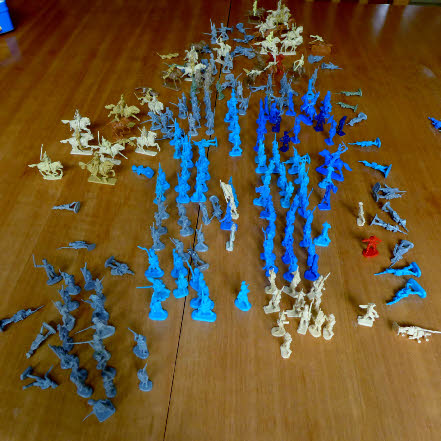
Picture 4: the Netherlands/ British troops (not shown) had regrouped and continued a firefight at thesecond line; the 27th Jaegers on the French far left have not retired.
This second phase fire fight had produced further casualties. And now the Inniskillings are now into the affray!
The numbers
The following table tabulates how I arrived at the numbers to be represented.
First I constitute my two battalion regiment. This is reduced on a 4:1 ratio.
Then I have guessed at the detailed causalities over the course of the advance.
The moment that the British dragoons make contact,the regiment had suffered 20% casualties.
However, the leading battalion had nearer 30% so was much closer to ‘breaking’ point.
The plan would have been for the 2nd battalion to have swapped places by this time but the physical conditions and heat of battle precluded this.
The following table tabulates how I arrived at the numbers to be represented.
First I constitute my two battalion regiment. This is reduced on a 4:1 ratio.
Then I have guessed at the detailed causalities over the course of the advance.
The moment that the British dragoons make contact,the regiment had suffered 20% casualties.
However, the leading battalion had nearer 30% so was much closer to ‘breaking’ point.
The plan would have been for the 2nd battalion to have swapped places by this time but the physical conditions and heat of battle precluded this.
